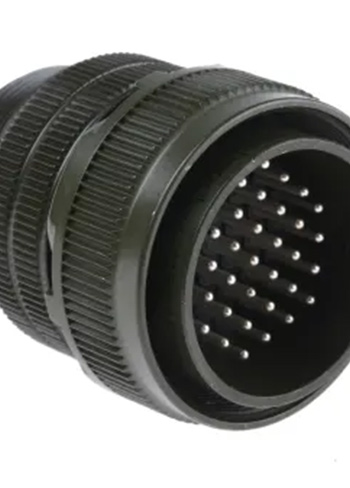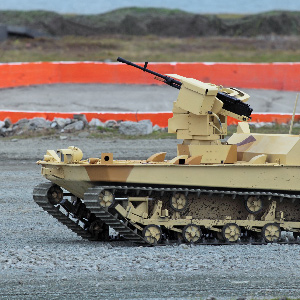What Are MIL-SPEC Connectors?
At some point in an electrical or electronic engineering career, you might come across MIL-SPEC Connectors, also known as MS or Military Standard Connectors. These electrical or fibre optic circular shell connectors were originally developed by the military for tactical service and aeronautic applications in the 1930s, and were then called AN or Army/Navy connectors.
They're now a standard feature in military equipment and other severe or demanding environments, including marine, aerospace, oil and gas applications, and various industrial and automotive contexts. This type of electrical connector was specifically developed to protect the connection against the harshest possible environments, and is designed for durability. Depending on the application, connectors can be selected for resistance to corrosion, vibration, extremes of temperature, and more.
MIL-SPEC connectors are usually composed of a mating pair, one half of which is a plug and the other a receptacle. Each pair must match a male (pin) contact with a female (socket) contact. For making electrical connections, the connectors are commonly made of a phosphor-bronze or beryllium-copper alloy. This is then plated with some type of highly conductive and non-corrosive metal, such as gold.
For fibre optic connections, the connectors are usually male plug connectors that feature a protruding ferrule. This holds the fibres in place, and lines up the two fibres so that the connection can be made. An important specification to take into account when selecting fibre optic connectors is the insertion loss. This is a measurement in decibels (dB) of the amount of signal power or light that will be lost in making the connection.

Choosing Your MIL-SPEC Connector
You need to have a few basic things in mind when you're choosing your MIL-SPEC connectors. Product parameters to take into account include the number, type, size and coupling method of the contacts, the shell specifications, and the terminals.
Contacts
The number of contacts defines how many conductive elements are present in a MIL-SPEC connector. These elements provide the electrical path when the connection is formed between the two types of contact, either pins or sockets. Contact sizes are usually designated in AWG (American Wire Gauge) measurements and differentiate the contacts from each other. There are various different types of coupling available:
- Threaded coupling engages the screw threads on the mating connectors.
- Bayonet coupling provides fast locking and jacking capability but with limited rotation. It provides constant impedance and is commonly used for network or video transmission via coaxial cables.
- Breech lock coupling has a removable locking ring that can join the components together safely and be dismantled easily for cleaning and maintenance.
- Quick connect/spring rack coupling is used in a wide range of industries for corrosive liquid flow applications.
- Ball detent coupling is a self-locking, quick push-pull coupling that can protect rotating elements from damage due to overloading.
Connector Shells
The main housing for the connector is usually called the shell, often made of aluminium which has been anodised or plated for protection against corrosion. Shell housings are available in various styles, including:
- Straight or angled plug
- In-line or cable receptacle
- Wall or box-mount receptacle
- Dummy receptacle
- Jam nut receptacle
- Solder or weld-mount receptacle
- Through-bulkhead receptacle
Standard connector shells come in a range of sizes, starting at size 8 (0.50") and increasing in 0.0625" increments up to size 36 (2.25"). Circular MIL-SPEC connectors have a cylindrical shell that comes in incremental diameter sizes starting at about 0.375". MIL-SPEC connectors attach back-shells to the shell housing using threads, and are usually equal to the connector shell size or within 0.062" of it.
Connector shells are gendered as male or female. The male plug – sometimes called a free connector or header – is normally moveable and attached to a removable sub-assembly cable. It's inserted into a female connector to make a circuit connection, which can be a jack, receptacle or other outlet.
Terminals
Terminals can be attached to studs, posts, or other types of conductor to make an electrical connection. There are several varieties of simple terminal device, including screws, lugs, cage clamps, wires soldered onto a PCB, quick-connect tabs and crimping. More complex terminals include inserting connectors into a solder cup or terminal and then soldering it to another metal surface; or making a connection by slicing through cable insulation with an IDC, or insulation displacement connector. This type of mass termination connector requires no stripping of insulation and is often used in flat cables. Other types of connection use THT (through-hole technology) to mount components by pushing them through holes in a PCB, or quick-disconnect lanyard release terminals. Solderless electrical connections can also be made using a special wrapping tool to wrap wire around a terminal post.
Military Specifications
MIL-SPEC connectors are specially designed to comply with military specifications.
MIL-C-5015: is a general use connector standard that specifies the most popular type of circular connector, used in commercial applications as well as military. This specification covers cylindrical electrical connectors with front and rear release contacts, made with removable crimp or solder contacts. These connectors are available in several classes, which are rated for operation from a minimum temperature of -55°C up to maximum temperatures of 125°C, 175°C or 200°C.
MIL-C-22992: is a connector standard for heavy-duty connectors that support very high power levels. This type of plug and receptacle electrical connector is a multi-contact, quick disconnect device used in military and industrial applications. They're rated for operation at -55°C up to 125°C.
MIL-C-26482: applies to two series of environment-resisting connectors with hermetic receptacles, plus associated accessories. These miniature circular connectors are the quick disconnect type. Both series can be interconnected if power contacts are used, and can't be interconnected if shielded contacts are used. Series I connectors of this specification are commonly found in military communication systems, as they offer excellent mechanical, electrical and environmental properties in a compact design.
MIL-C-26500: covers another group of miniature circular connectors that are designed to meet the environmental challenges of advanced missiles, rockets, aircraft and space vehicles. The plugs and receptacles in these connectors have socket contact inserts that feature a resilient face, while the mating pin inserts are specified with either a hard or a resilient face.
MIL-C-27599: is applicable to two series of miniature circular connectors that are high density, environmentally resistant, and offer quick-disconnect bayonet coupling. This type of electrical connector can operate continuously at temperatures from -65°C up to 175°C. These MIL-SPEC connectors can be interconnected with both series of MIL-C-38999 connectors.
MIL-C-38999: refers to two further series of connectors that are very similar to MIL-C-27599, with which they can be interconnected.
MIL-C-81703: applies to three further series of environment-resisting, miniature circular connectors and accessories. This type of connector is specified with non-removable solder and/or removable crimp contacts.
MIL-C-83723: This type of connector is identical to MIL-C-26482 Series II and has therefore been inactivated.
MIL-DTL-5015: specifies the go-to connector for the ground support and airframe requirements of the military aerospace industry. These rear release connectors are known for their reliability and combine the best features of several older models.
MIL-DTL-32139: specifies a MIL-SPEC connector for joint services administered by the US Defence Supply Centre (DSCC). It relates to nano-miniature connectors made from both plastic and metal.
MIL-DTL-38999: covers four series of high density, environmentally resistant, miniature circular connectors, with either threaded, bayonet or breech coupling. This type of connector specifies fixed hermetic solder or removable crimp contacts, and is rated for operation at temperatures of -65°C up to 200°C.
MIL-DTL-83513: is another type of DSCC joint services specification that applies to both metal and plastic shell Micro-D connectors. It incorporates revisions to the original MIL-C-83513 that changed its title to a DTL specification. This was done in order to adopt industry standards and performance-driven specifications.
MIL-DTL-83723: is an umbrella standard governing environmentally resistant circular connectors, together with their contacts and associated accessories. All MIL-DTL-83723 connectors are designated with crimp or solder contacts and must be able to function within specified temperature ranges.
Other Unlisted Military Standards
Other standards exist that also govern MIL-SPEC connectors.
RoHS compliant connectors are manufactured in accordance with the EU Restriction of Hazardous Substances (RoHS) directive. This requires all products sold in Europe to contain only minimal levels of mercury, lead or cadmium, polybrominated biphenyl, polybrominated diphenyl ether or hexavalent chromium.
An ARINC connector for interfacing avionic equipment must comply with the technical standards applicable to the avionic industry.
Special Features
MIL-SPEC connectors are also available with special additional features for specific environmental applications:
- Underwater use connectors have appropriate sealing for use in underwater applications.
- Hermetically sealed connectors prevent leakage of any internal moisture.
- Integrated filter connectors incorporate a filter that protects them from magnetic interference or unwanted signals.
- ESD/EMI shield or RFI/EMI filter connectors are shielded against electrostatic discharge (ESD) and/or electromagnetic interference (EMI), or contain a filter to prevent radio frequency interference (RFI), and/or EMI.
- Environment-resistant connectors are designed to withstand such environmental challenges as dirt, sun, chemicals, etc.
Get More From Rowse Straight To Your Inbox




